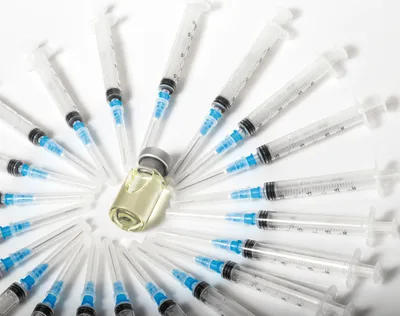Links Between Psoriasis and Multiple Myeloma

Psoriasis is a common long-term skin condition that causes red, itchy, scaly patches and affects over 100 million people worldwide. Meanwhile, multiple myeloma (MM) accounts for 10% of all blood cancers in the US.
Because multiple myeloma is an immune disorder, as is psoriasis, the HealthTree for Multiple Myeloma research team evaluated connections between the two dieases after learning from HealthTree Cure Hub data that psoriasis was the most prevalent co-immune system condition for myeloma patients.
Other co-disorders found in the HealthTree Cure Hub data included osteopenia (reduced bone mass), inflammatory bowel disease (chronic inflammation of the digestive tract), and gout (a form of arthritis caused by uric acid deposits in the joints).
Physicians often face difficult decisions in treating patients diagnosed psoriasis and multiple myeloma due to limited research about the intersection between these two conditions.
For example, treating psoriasis with systemic immunotherapies in patients with multiple myeloma can be challenging because of concerns about immunosuppression (having a weakened immune system and difficulty fighting infections) and the possible worsening of multiple myeloma.
Looking at similarities with between the diseases, it was noted that Interleukin-17 (IL-17) has been identified as a cytokine that promotes both psoriasis and multiple myeloma; however, the use of IL-17 inhibitors in patients with multiple myeloma has not been examined. By using online platforms such as HealthTree Curehub we can gain a greater understanding of the clinical characteristics and treatment responses of patients diagnosed with both psoriasis and multiple myeloma.
The HealthTree study was performed in collaboratation with psorisais genomics expert Wilson Lio, MD, Phd of the University of California at San Francisco (UCSF). Using the HealthTree CureHub platform, we evaluated a total of 1505 patients with a verified diagnosis of multiple myeloma. Psoriasis was present in 4.9% of these patients.
We examined the demographics (such as gender and age) and clinical characteristics (such as psoriasis type, psoriasis treatment history, myeloma type, myeloma genetic features, and myeloma association with bone damage, hypercalcemia, or osteopenia) of patients diagnosed with psoriasis and multiple myeloma. We also investigated the use of systemic immunomodulators for treatment of psoriasis in patients with multiple myeloma.
A questionnaire was sent to 73 HealthTree patients with a confirmed diagnosis of both psoriasis and multiple myeloma and we received 18 complete responses from these patients.
Psoriasis Characteristics
- The mean age of psoriasis diagnosis was 35 years old
- The mean age of myeloma diagnosis was 57 years old
- In most patients, diagnosis of psoriasis occurred well before diagnosis of myeloma
- The most common type of psoriasis diagnosed was plaque psoriasis (which causes dry, raised, red skin lesions covered with silvery scales), with 44% of patients reporting this type
- Other psoriasis diagnoses in these patients were:
- Palm/sole
- Guttate (which produces tiny, pink-red, scaly ‘raindrops’ over the body)
- Inverse psoriasis (which occurs in areas where the skin folds)
- Inverse psoriasis was the least common, with only 5.6% being this type
- 11.1% of the patients indicated that their psoriasis treatment (topical steroids) had improved their multiple myeloma, and 33.3% indicated they were uncertain
- No patients reported that psoriasis treatment had negatively influenced myeloma progression, and 50% were uncertain
- Psoriasis treatments were most commonly topical steroids, followed by tar, phototherapy, heliotherapy, and antifungal or immunosuppressive agents
Myeloma Characteristics
- 72.2% of the patients had active multiple myeloma
- 33.3% of the patients had prior smoldering myeloma
- 27.8% of the patients had prior MGUS
- The most common subtype of myeloma was IgG kappa (50%)
- The rest of the subtypes were IgA kappa (11.1%), IgA lambda (11.1%), and IgM lambda (5.6%), and 22.2% uncertain
- Among the participants, 29.4% reported bone damage (e.g., fracture), 16.7% reported high calcium levels, and 33.3% reported osteopenia (decreased bone mass)
Key Findings
- We identified a patient with psoriasis and active myeloma who was treated with the IL-17 inhibitor ixekizumab and who then had a 2-month reduction in her myeloma serologic markers (such as M-protein, kappa, and kappa: lambda ratio)
- Among the 18 patients, 4 patients were treated with a systemic immunomodulator for psoriasis with no obvious worsening of multiple myeloma progression. This finding is encouraging because it indicates that systemic biologic immunotherapies for psoriasis can potentially be used in individuals with additional diseases such as multiple myeloma.
- Our results validate crowdsourcing as a way to assess patient demographics and treatment responses for use in dermatology research
- We were able to examine the demographics of patients diagnosed with psoriasis and multiple myeloma and investigate the use of systemic immunomodulators to treat psoriasis in multiple myeloma patients
- The majority of the patients in this study were IgG kappa, which suggests that future research is needed to determine whether patients with certain myeloma subtypes may have a predisposition toward the development of psoriasis, or vice versa
- Our study reports that patients generally develop psoriasis much earlier than multiple myeloma with an average difference of 21.2 years in time of diagnosis, which has implications for close monitoring of psoriasis therapies given new malignant diagnoses
- No studies have examined the use of biologics for psoriasis in patients with multiple myeloma, which means there is need for additional research on immunomodulatory biologics in patients with psoriasis and multiple myeloma
- Further research in this area, particularly the use of anti-IL-17 biologics, should be explored
Using HealthTree Cure Hub to Advance Myeloma Research
Our main goals at the HealthTree Foundation are to provide innovative tools to empower patients to find their best myeloma treatments and accelerate scientific research by enabling the contribution of health data. We do this with our HealthTree CureHub platform where more than 10,000 patients have registered to take advantage of the free tools we provide, such as the twin machine, treatment options tool and the myeloma specialist directory.
By taking advantage of patient health data available on HealthTree, researchers can better understand the clinical characteristics and treatment responses of patients diagnosed with psoriasis and multiple myeloma.
If you are a patient with multiple myeloma and would like to contribute to research, you can create a HealthTree CureHub account here.
References
- Clinical Characteristics of 18 Patients with Psoriasis and Multiple Myeloma Identified Through Digital Health Crowdsourcing: https://link.springer.com/article/10.1007/s13555-020-00416-5
- Sanchez IM, Shankle L, Wan MT, Afifi L, Wu JJ, Doris F, et al. Building a citizen pscientist: advancing patient-centered psoriasis research by empowering patients as contributors and analysts. Dermatol Ther [Internet]. 2018;8(3):405–23.
- Myeloma Crowd Launches a Psoriasis / Multiple Myeloma Study Using Its HealthTree® Platform [Internet]. [cited 2022 May 12]: https://www.myelomacrowd.org/myeloma/community/articles/myeloma-crowd-launches-a-psoriasis-multiple-myeloma-study-using-its-healthtree-platform
- Rajkumar SV. Multiple myeloma: 2020 update on diagnosis, risk-stratification and management. Am J Hematol [Internet]. 2020;95(5):548–67.
Psoriasis is a common long-term skin condition that causes red, itchy, scaly patches and affects over 100 million people worldwide. Meanwhile, multiple myeloma (MM) accounts for 10% of all blood cancers in the US.
Because multiple myeloma is an immune disorder, as is psoriasis, the HealthTree for Multiple Myeloma research team evaluated connections between the two dieases after learning from HealthTree Cure Hub data that psoriasis was the most prevalent co-immune system condition for myeloma patients.
Other co-disorders found in the HealthTree Cure Hub data included osteopenia (reduced bone mass), inflammatory bowel disease (chronic inflammation of the digestive tract), and gout (a form of arthritis caused by uric acid deposits in the joints).
Physicians often face difficult decisions in treating patients diagnosed psoriasis and multiple myeloma due to limited research about the intersection between these two conditions.
For example, treating psoriasis with systemic immunotherapies in patients with multiple myeloma can be challenging because of concerns about immunosuppression (having a weakened immune system and difficulty fighting infections) and the possible worsening of multiple myeloma.
Looking at similarities with between the diseases, it was noted that Interleukin-17 (IL-17) has been identified as a cytokine that promotes both psoriasis and multiple myeloma; however, the use of IL-17 inhibitors in patients with multiple myeloma has not been examined. By using online platforms such as HealthTree Curehub we can gain a greater understanding of the clinical characteristics and treatment responses of patients diagnosed with both psoriasis and multiple myeloma.
The HealthTree study was performed in collaboratation with psorisais genomics expert Wilson Lio, MD, Phd of the University of California at San Francisco (UCSF). Using the HealthTree CureHub platform, we evaluated a total of 1505 patients with a verified diagnosis of multiple myeloma. Psoriasis was present in 4.9% of these patients.
We examined the demographics (such as gender and age) and clinical characteristics (such as psoriasis type, psoriasis treatment history, myeloma type, myeloma genetic features, and myeloma association with bone damage, hypercalcemia, or osteopenia) of patients diagnosed with psoriasis and multiple myeloma. We also investigated the use of systemic immunomodulators for treatment of psoriasis in patients with multiple myeloma.
A questionnaire was sent to 73 HealthTree patients with a confirmed diagnosis of both psoriasis and multiple myeloma and we received 18 complete responses from these patients.
Psoriasis Characteristics
- The mean age of psoriasis diagnosis was 35 years old
- The mean age of myeloma diagnosis was 57 years old
- In most patients, diagnosis of psoriasis occurred well before diagnosis of myeloma
- The most common type of psoriasis diagnosed was plaque psoriasis (which causes dry, raised, red skin lesions covered with silvery scales), with 44% of patients reporting this type
- Other psoriasis diagnoses in these patients were:
- Palm/sole
- Guttate (which produces tiny, pink-red, scaly ‘raindrops’ over the body)
- Inverse psoriasis (which occurs in areas where the skin folds)
- Inverse psoriasis was the least common, with only 5.6% being this type
- 11.1% of the patients indicated that their psoriasis treatment (topical steroids) had improved their multiple myeloma, and 33.3% indicated they were uncertain
- No patients reported that psoriasis treatment had negatively influenced myeloma progression, and 50% were uncertain
- Psoriasis treatments were most commonly topical steroids, followed by tar, phototherapy, heliotherapy, and antifungal or immunosuppressive agents
Myeloma Characteristics
- 72.2% of the patients had active multiple myeloma
- 33.3% of the patients had prior smoldering myeloma
- 27.8% of the patients had prior MGUS
- The most common subtype of myeloma was IgG kappa (50%)
- The rest of the subtypes were IgA kappa (11.1%), IgA lambda (11.1%), and IgM lambda (5.6%), and 22.2% uncertain
- Among the participants, 29.4% reported bone damage (e.g., fracture), 16.7% reported high calcium levels, and 33.3% reported osteopenia (decreased bone mass)
Key Findings
- We identified a patient with psoriasis and active myeloma who was treated with the IL-17 inhibitor ixekizumab and who then had a 2-month reduction in her myeloma serologic markers (such as M-protein, kappa, and kappa: lambda ratio)
- Among the 18 patients, 4 patients were treated with a systemic immunomodulator for psoriasis with no obvious worsening of multiple myeloma progression. This finding is encouraging because it indicates that systemic biologic immunotherapies for psoriasis can potentially be used in individuals with additional diseases such as multiple myeloma.
- Our results validate crowdsourcing as a way to assess patient demographics and treatment responses for use in dermatology research
- We were able to examine the demographics of patients diagnosed with psoriasis and multiple myeloma and investigate the use of systemic immunomodulators to treat psoriasis in multiple myeloma patients
- The majority of the patients in this study were IgG kappa, which suggests that future research is needed to determine whether patients with certain myeloma subtypes may have a predisposition toward the development of psoriasis, or vice versa
- Our study reports that patients generally develop psoriasis much earlier than multiple myeloma with an average difference of 21.2 years in time of diagnosis, which has implications for close monitoring of psoriasis therapies given new malignant diagnoses
- No studies have examined the use of biologics for psoriasis in patients with multiple myeloma, which means there is need for additional research on immunomodulatory biologics in patients with psoriasis and multiple myeloma
- Further research in this area, particularly the use of anti-IL-17 biologics, should be explored
Using HealthTree Cure Hub to Advance Myeloma Research
Our main goals at the HealthTree Foundation are to provide innovative tools to empower patients to find their best myeloma treatments and accelerate scientific research by enabling the contribution of health data. We do this with our HealthTree CureHub platform where more than 10,000 patients have registered to take advantage of the free tools we provide, such as the twin machine, treatment options tool and the myeloma specialist directory.
By taking advantage of patient health data available on HealthTree, researchers can better understand the clinical characteristics and treatment responses of patients diagnosed with psoriasis and multiple myeloma.
If you are a patient with multiple myeloma and would like to contribute to research, you can create a HealthTree CureHub account here.
References
- Clinical Characteristics of 18 Patients with Psoriasis and Multiple Myeloma Identified Through Digital Health Crowdsourcing: https://link.springer.com/article/10.1007/s13555-020-00416-5
- Sanchez IM, Shankle L, Wan MT, Afifi L, Wu JJ, Doris F, et al. Building a citizen pscientist: advancing patient-centered psoriasis research by empowering patients as contributors and analysts. Dermatol Ther [Internet]. 2018;8(3):405–23.
- Myeloma Crowd Launches a Psoriasis / Multiple Myeloma Study Using Its HealthTree® Platform [Internet]. [cited 2022 May 12]: https://www.myelomacrowd.org/myeloma/community/articles/myeloma-crowd-launches-a-psoriasis-multiple-myeloma-study-using-its-healthtree-platform
- Rajkumar SV. Multiple myeloma: 2020 update on diagnosis, risk-stratification and management. Am J Hematol [Internet]. 2020;95(5):548–67.

about the author
Patricia Flores
Patricia is an International Medical Graduate who joined HealthTree in 2020 as part of the Patient Experience team. She helps patients understand and track their lab & genetic test results as well as relevant information from their health history. She loves ballet, traveling, and reading a good science fiction book as often as possible.
More on HealthTree Research
Trending Articles




Get the Latest Multiple Myeloma Updates, Delivered to You.
By subscribing to the HealthTree newsletter, you'll receive the latest research, treatment updates, and expert insights to help you navigate your health.
Together we care.
Together we cure.
3x Faster.












